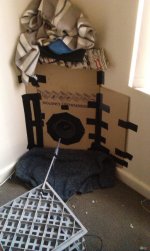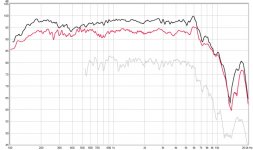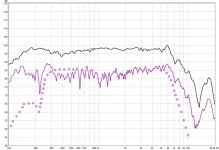Trying it out with headphones & an equaliser, a 3dB dip at 1kHz is barely detectable. I only hear it with some material, e.g. vocals with breath noise / that appear to be sung very close to the mic. I also also only notice it with my left ear - the effect is masked if I use both headphones.not obviously trivial but not clearly important either, hence the idea to test.
I think my R ear is less sensitive today due to mild hayfever; I have some fluid in my R eustachian tube.
This is one way that measurements trump subjectivity. If I built a system based on how my hearing is today, I might notice defects when I'm feeling a little better, or after taking an antihistamine, after exercising, etc. Also, someone else (younger / with better pitch recognition / with better HF hearing) might hear more flaws than I do.
Yea. This is mostly about intellectual curiosity / trying something different.Even if the audible difference is small I am still quite interested as an intellectual problem, because the cause of the dip is a bit of a mystery.
And a smoother response can only help, at worst won't hurt.
I already have a decent system, and headphones. If I was purely a music lover, that would be enough. This project appeals to the same nerdy impulses that makes people hobbyists or collectors.
Most of the research, especially older papers, about audibility of dips and peaks is flawed by making assumptions about what is an "ordinary music input".
Is Metallica's "Death Magnetic" ordinary or is it deviant? With that kind of music dips and peaks of 1dB and less are readily audible in a gapless A/B comparison, even quite narrowband ones. Put on some smooth jazz, chamber music, the typical audiophile recordings you get exposed to at any hifi show, and you won't notice even severe response irregularities.
Is Metallica's "Death Magnetic" ordinary or is it deviant? With that kind of music dips and peaks of 1dB and less are readily audible in a gapless A/B comparison, even quite narrowband ones. Put on some smooth jazz, chamber music, the typical audiophile recordings you get exposed to at any hifi show, and you won't notice even severe response irregularities.
...with headphones & an equaliser, a 3dB dip at 1kHz is barely detectable. I only hear it with some material
Have you tried it with white noise or pink noise?
Not "musical" but should reveal audible difference quite well.
I checked and my university library has Buchlein so I will have a look in the next few days.
Yea. This is mostly about intellectual curiosity...
I already have a decent system, and headphones...
I also use headphones, some now unobtainable mains powered Stax electrostatics and they're decent too.
In fact more than decent, if only for the unobtainability
I have JBL speaker components but I would like to build some speaker drivers eventually.
My old university physics notes have helped me work out the electromagnetics but the actual cone construction is a bit trial and error at this point.
Hence my interest in your experiments.
Best wishes
David
KSTR. Your comments seem to support my belief that the dip will probably be audible, on at least some material, and to test with noise too, Toole comments that typical music is not the best material to reveal subtleties.
Last edited:
Klippel has some really interesting literature on this topic: https://www.klippel.de/fileadmin/kl...ement_and_Visualization_Cone_vibration_06.pdf
I'm no expert on this stuff, but section 5.3 Surround Resonance could partly explain the dip around 800Hz; although looking back at your close up FR measurements the dustcap and surround look very similar in the range.
I'm no expert on this stuff, but section 5.3 Surround Resonance could partly explain the dip around 800Hz; although looking back at your close up FR measurements the dustcap and surround look very similar in the range.
Last edited:
If you don't find you can hear a difference in non-blind testing, there can't be much difference. But if you do hear a difference in non-blind testing, might not be there either.
For sure, there are testing signals that make say "flaws" in a speaker plainly audible that are totally undetectable with music playing. An example is stereo localization which you can do OK as low as maybe 80 Hz with sine waves, as the textbooks say; but with acoustic music, no sense of localization below maybe 140 Hz (as anyone who's done it with sharp slopes and clean speakers can say).
Dave Zan wonders about the innocence of "interventions", say, EQ to address the 800 Hz issue. That in turn relates to the question of whether a speaker is the sum of its (usual) measurements which has been debated in threads about motional feedback.
I think I'd refer to Ishihara Plates (the colour blindness test, but many other visual "illusions" analogously). It may be if you insert 800 Hz EQ it is like seeing the embedded digits: the EQ is always audible even if in the natural course of listening to acoustic music, the 800 Hz behaviour of the driver is not. Stated differently, we are "colour blind" to some sound effects that are obvious to mics but not to other effects. Just a thought.
B.
For sure, there are testing signals that make say "flaws" in a speaker plainly audible that are totally undetectable with music playing. An example is stereo localization which you can do OK as low as maybe 80 Hz with sine waves, as the textbooks say; but with acoustic music, no sense of localization below maybe 140 Hz (as anyone who's done it with sharp slopes and clean speakers can say).
Dave Zan wonders about the innocence of "interventions", say, EQ to address the 800 Hz issue. That in turn relates to the question of whether a speaker is the sum of its (usual) measurements which has been debated in threads about motional feedback.
I think I'd refer to Ishihara Plates (the colour blindness test, but many other visual "illusions" analogously). It may be if you insert 800 Hz EQ it is like seeing the embedded digits: the EQ is always audible even if in the natural course of listening to acoustic music, the 800 Hz behaviour of the driver is not. Stated differently, we are "colour blind" to some sound effects that are obvious to mics but not to other effects. Just a thought.
B.
Last edited:
This is my improved test baffle. The top is semi open / a leaky edge, at roughly double the distance of the prior baffle's closest edges.
After taking the photo, I also placed pillows and blankets to reduce floor bounce & 1st reflections.
The graph shows-
RED: old baffle, mic @ 10cm (with 800Hz dip)
BLACK: corner baffle, mic @ 10cm
GREY: the average of several measurements taken @ 1 metre, 15-20degrees off axis.
I think this one correlates best to real world listening, since my head is not equipped with a single stationary ear
This is all with a slightly tweaked driver - frame caulked, light foam on the back of the cone, dust cap painted. The tweaks mildly improved the impulse plots and HF breakup.
Subjectively it sounds fine, with just the <200Hz range filtered out.
I'll keep tinkering in about a week. I'd like to see how it goes in a minimal crossover system.
After taking the photo, I also placed pillows and blankets to reduce floor bounce & 1st reflections.
The graph shows-
RED: old baffle, mic @ 10cm (with 800Hz dip)
BLACK: corner baffle, mic @ 10cm
GREY: the average of several measurements taken @ 1 metre, 15-20degrees off axis.
I think this one correlates best to real world listening, since my head is not equipped with a single stationary ear
This is all with a slightly tweaked driver - frame caulked, light foam on the back of the cone, dust cap painted. The tweaks mildly improved the impulse plots and HF breakup.
Subjectively it sounds fine, with just the <200Hz range filtered out.
I'll keep tinkering in about a week. I'd like to see how it goes in a minimal crossover system.
Attachments
Last edited:
Umm, red one looks best; no big trough 250-1k Hz (although that's the kind of curve that can be tweaked satisfactorily with some gentle EQ). Red and black have identical plus and minus 2.5 dB bands. But either would be quite good by real-world comparisons, judged only from those two traces.
Just armchair eyeball comment from me.
B.
Just armchair eyeball comment from me.
B.
Those black vs red are academic plots for problem finding. The mic is too close to be 'real world'.
This is another 1m plot (on axis), a somewhat better indicator of real-world performance. The ~15degree off-axis plots don't have the HF rise.
The dots show what I might aim for with a 1.5 way midrange:
Bandpass points 300Hz and 5kHz
Additional driver(s) 300-600Hz
Without a high pass filter, the 2HD levels climb at high SPL, which I guess is from the limited excursion.
This is another 1m plot (on axis), a somewhat better indicator of real-world performance. The ~15degree off-axis plots don't have the HF rise.
The dots show what I might aim for with a 1.5 way midrange:
Bandpass points 300Hz and 5kHz
Additional driver(s) 300-600Hz
Without a high pass filter, the 2HD levels climb at high SPL, which I guess is from the limited excursion.
Attachments
Last edited:
- Status
- This old topic is closed. If you want to reopen this topic, contact a moderator using the "Report Post" button.
- Home
- Loudspeakers
- Multi-Way
- Measurement based cone damping / treatment


